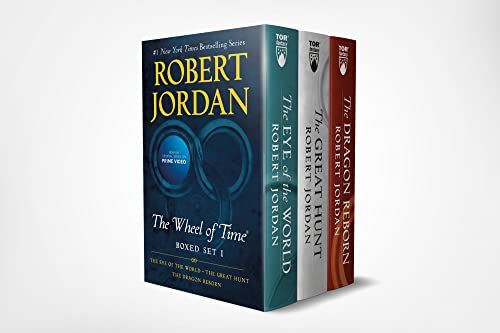If you’ve ever wondered what it feels like to carry a brick in your backpack for a year, you must be thinking about reading this series. Welcome to my review! I’ve read, lugged, and at times, used paperbacks from this set for light arm workouts. Today, I’ll give you the highs, the lows, and the honest scoop on Wheel of Time. Whether you want magic, marathon reading, or just something sturdy to prop up a table, this review will spill it all. Grab your bookmarks and maybe a snack—let’s get into it!
Steve’s Wheel of Time Review
In a nutsheel
The Wheel of Time by Robert Jordan is a fantasy story bigger than my grandma’s stew pot. This series rolls out a wild mix of epic quests, ancient magic, and world-shaking battles. (Trust me, there’s enough adventure here to make even my lazy cat want to go questing.)
You’ll find yourself in a world where time is a wheel and every turn brings heroes, villains, and the kind of destiny that makes you sweat just reading about it. Jordan’s writing hooks you with smart world-building, tossed with classic themes of friendship, fate, and the big ol’ struggle between good and evil. If you like your fantasy with magic, mystery, and more characters than a family reunion, this one’s your ticket.
Epic World-Building and Unique Magic System in Wheel of Time
Let me tell you right away, the world in Wheel of Time is so big, it makes my living room look like a shoebox. And trust me, I have a pretty big living room (okay, maybe not that big, but my cat gets lost in it once a week). Robert Jordan, the author, doesn’t just toss in a castle here and a dark forest there—this guy drew maps so detailed I almost needed a GPS to keep up! Each kingdom, town, and creepy ruin has a history, and sometimes the townsfolk talk about it so much you wish you could get a word in yourself.
What gets me giddy is the way Jordan nails the little things. You get streets full of unique foods (I tried to make honey cakes once—big mistake), songs, even off-colour jokes told by farmers. The cultures are all different too: you got folks who cover their faces, people who don’t, warriors who don’t let you finish your breakfast in peace. It all just feels real, like if I squint hard enough, I’ll spot a trolloc in the garden.
Now, about the magic system—it isn’t your average “wave a wand, poof!” deal. In Wheel of Time, magic is called the One Power, and only some people can use it. There’s a whole split between men and women using magic, and, spoiler alert, the men tend to go a bit bonkers (could be all the pressure). But the rules are clear, and there’s no “I win” spell, which makes things tense and fun to watch. My friend tried to explain the weaving of different elemental powers to me and ended up making a knot out of my shoelaces instead.
If you’re like me and enjoy a world you can—you know—get lost in, this is the book to try. Trust me, the real adventure starts when you meet the unforgettable characters, and that’s exactly what we’re talking about next: Character growth and cast shenanigans!
Unforgettable Character Growth and Cast Dynamics in Wheel of Time
If there’s one thing Wheel of Time nails, it’s raising a bunch of farm kids, nobles, and troublemakers into full-blown legends (with an occasional donkey thrown in just for fun). I started reading this series with my own group of pals, and we could not stop arguing about who was the most annoying or who needed a good nap the most. Wheel of Time gives you Rand, Mat, Perrin, Egwene, Nynaeve and a cast so packed, you need a flowchart just to keep track.
Every character’s arc feels earned, and by book six or seven, you actually believe these people have seen some stuff (seriously, the amount of life lessons and trauma handed out is impressive). Nynaeve’s stubbornness, Mat’s reluctant heroism, and Perrin’s wolfy struggles kept me laughing, groaning, and—okay—sometimes threatening to toss the book across the room. My friend Becky still rants about Rand’s ‘angsty phase’ three years later.
The friendships and the drama give Wheel of Time its pulse. Sometimes you get the warm fuzzies, and next page someone’s betraying you or running off with a magical object. It’s not always smooth. A few side characters could do with a bit less cloak swishing, and occasionally, Robert Jordan seems to forget how old some of his main characters are, but the series does keep you investing in the gang.
Plus, there’s no shortage of intense training montages and bar room brawls. The group dynamics feel real, messy, and just a bit like my family reunions. Don’t worry—next up, we’ll be tackling the rollercoaster that is Wheel of Time’s story pacing and book length. Buckle up and grab a snack!
How Wheel of Time’s Epic Length Tests Your Patience (and Butt Muscles)
If you’ve ever wanted to measure time by chapters instead of hours, Wheel of Time is your new stopwatch. Robert Jordan really lets the story stretch its legs—maybe a little too much. I remember reading these books with my friends, taking bets on whether we’d finish before we grew beards (spoiler: some of us did, ladies included). The series is made up of fourteen massive novels plus a prequel. That’s enough paper to prop up a wobbly table for decades.
Pacing-wise, Wheel of Time sometimes sprints like it’s late for dinner, then strolls like it’s window shopping. One moment, everything’s exploding and people are yelling about prophecies, and the next, they’re discussing embroidery for three pages. I get it, world-building is important, but I’ve never read so much about cloaks in my life. There are whole chapters where I wondered if my copy was stuck on repeat.
But when Jordan picks up the pace, wow, it flies. You’ll be so hooked you forget to eat (or maybe that’s just me and my competitive buddies). The big events—especially the battles—pay off the slow build-up. It’s a classic case of “stick with it and you’ll be rewarded,” but you definitely need patience (and maybe a comfy chair).
My advice? Pace yourself, stock up on snacks, and take breaks to touch grass. This epic is a marathon, not a sprint. Now that we’ve tripped over the finish line of page counts, let’s talk about the box set itself—because you can’t judge a book by its cover, but you sure can judge a box set by its design!
Is the Wheel of Time Box Set Worth Its Weight?
First, let’s talk about what’s in the box. When my Wheel of Time box set landed on my doorstep, I thought Amazon had delivered bricks. This thing is heavy. You could use it as a doorstop—or as a last defense against the Shadow if it ever comes knocking.
The covers are pretty. I’ll give them that. Some editions have art that makes you feel like you’re in another world. They do catch the eye on a shelf and tell visitors: “Yes, I am the sort of person who reads epic things.” The spines line up nicely, too. That’s a small thing, but a shelf full of crooked spines makes my eye twitch.
Pages are thin, but not the scary thin where you feel like turning one might break it. Print is big enough that you won’t go cross-eyed, even if you read deep into the night. I spilled coffee on one and, surprise, it survived. Guess Robert Jordan knew his audience.
Now, for the box itself. It’s cardboard. It does the job, but if you move house more than twice, it might look like it’s been through the Last Battle. So handle with care and don’t use it as furniture.
Do I recommend this box set? Yes, unless you already have commitment issues. Owning the Wheel of Time box set is both a flex and a life decision. Your bookshelf will thank you. Your social life might not.
Conclusion
Well folks, that wraps up my review of the mighty Wheel of Time! This series is like a marathon—don’t start unless you have comfy shoes, snacks, and maybe a support group. The world is rich, the magic system is clever, and the characters actually learn from their mistakes (imagine that!). Yes, the pacing can lag and the stack of books will scare your bookshelf, but if you want an epic adventure with plenty of drama, this is your ticket. Thanks for sticking with me to the end—your stamina is worthy of Aes Sedai gossip. Happy reading and may your bookmark never get lost!


